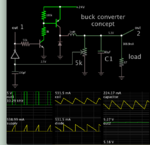Follow along with the video below to see how to install our site as a web app on your home screen.
Note: This feature may not be available in some browsers.
Hi, KlausST. I just want to learn. Thats why i choose the hard way. I know its tough but lets see.I wonder what's the idea behind that starters do it the hard way...design all discrete from the scratch....without detailed tutorial.
For starters, the optocoupler is backwards.
It should be LED to the right side, and phototransistor to the left.
Also you would use multi tapped secondaries, because otherwise your linear 5V and 3V3 regulators would be dissipating more power than what they are delivering.
I can't see the primary side working at all well - the main transistor is not turned off appropriately (?) - there is cktry missing ...

I know its tough but lets see.
